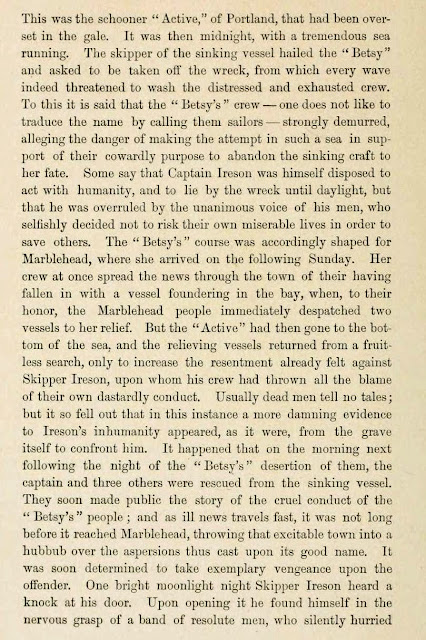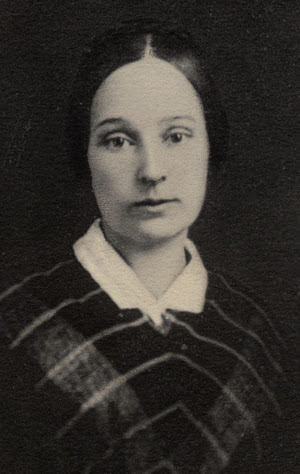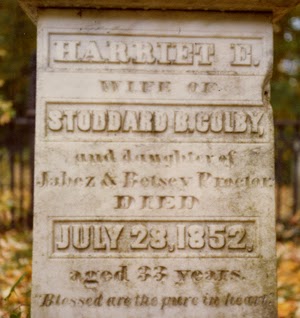Stoddard Benham Colby was born February 3 1816 Derby, Vermont and passed on September 21 1867 in Haverhill, New Hampshire
Line to Anthony Colby
ANTHONY COLBY (bp.1605 - 1660) of Horbling,
Boston, Ipswich, Salisbury and Amesbury m. Susanna
Unknown (d. 1689)
|
|
SAMUEL COLBY (abt 1638 - 1715/6) of Amesbury m.
Elizabeth Sargeant
|
|
SAMUEL COLBY (b. 1671 - bef. 1746) of Amesbury m.
Dorothy Ambrose
|
|
ENS. ENOCH COLBY (1702 - 1780) of Hampton Falls
and Chester m. Abigail Sanborn
|
|
ENOCH COLBY (bp. 1728 - 1778) of Candia m. Abigail
Blaisdell
|
|
SAMUEL COLBY (1766 - 1834) of Thornton and Derby m.
Ruth French
|
|
CAPT. NEHEMIAH COLBY (1785 - 1862) of Derby m.
Melinda Larrabee (1790 - 1842)
|
|
HON. STODDARD BENHAM COLBY (1816 - 1867) of
Derby and Montpelier m. Harriet Elizabeth Proctor
|
|
LAURA MELINDA COLBY (1844 - 1921) m.
Brig. Gen. Asa Bacon Carey
|
Stoddard B. Colby read law at Lyndon, Vt; began practice at Derby; represented it in the Legislature of Vermont; removed to Montpelier, Vt, and there remained until 1864; was State's Attorney for Washington Co. in 1851 and 1852; became Register of the U. S. Treasury in Aug. 1864. He married, 1. Harriet Elisabeth Proctor, d. of the Hon. Jabez Proctor of Proctorsville, Vt, Feb. 11, 1840. 2. Ellen Cornelia Hunt, dau. of Caleb Hunt of Haverhill, July
12, 1855. (From Sketches of Alumni of Dartmouth College)
From Hon. Thomas Parker Redfield in "Biography of the Bar of Orleans County, Vermont" edited by Frederick W. Baldwin S B Colby was the second son of Hon. Nehemiah Colby was fitted for college in the law office of the late Isaac F. Redfield, which stood near his father's store in Derby Center. Mr. Colby was an apt and ready scholar, and Judge Redfield then fresh from college, gave him a thorough training, especially in the Greek and Latin languages, in which his young pupil had special aptitude. He entered Dartmouth College in the fall of 1832, and graduated with high honor in 1836. He studied law in the office of the late Senator Upham in Montpelier, and was admitted to the bar of Orleans county at the December term, 1838, and at once commenced practice at Derby, where he remained until 1846, representing the town of Derby in the legislature in 1841.

In 1846 he removed to Montpelier and formed a copartnership with the late Lucius B. Peck, under the firm name of Peck & Colby, and so continued until 1863, when Mr. Colby was made register of the treasury and removed to Washington. He held that office until his death. Mr. Colby was a ripe scholar, a facile and ready speaker, and from the first his manner at the bar was elegant, and his language choice and beautiful. He had a voice of peculiar compass and melody. He at once took high rank as a brilliant and accomplished advocate. He possessed a lively and vigorous imagination, and invested ideas and incidents with such charming beauty that a court or jury became insensibly and irresistibly enlisted and absorbed in the investiture with which he clothed a case.
 |
| Lucius B Peck |
This was no studied ornamentation, but the natural outpouring from that rich treasury which was entirely his own, and inexhaustibly full. He never essayed the emotional, and never addressed the passions of men, but he charmed them with the beautiful, and disgusted them with what was degrading and hateful, thereby enlisting their affection for the one, and arousing their contempt for the other, and by that he made sure their judgment. As a brilliant advocate he had no peer among us, and the profession suffered an irreparable loss when he was transferred to the service of the government. His great powers had a natural adaptation to his chosen profession, and his honor and his fame must rest there. It is a matter of regret, and we think on his part a mistake, that he ever left the profession. Mr. Colby in every emotion and in every fibre, was intellectual and spiritual. He had an utter dislike and contempt for all that was gross, sensual and degraded. His fidelity to the sacred trusts of social and domestic life was not a mere matter of policy, but of fixed duty. This made the ties of domestic life strong.
Obituary of L B Peck partner of S B Colby
HARRIET ELIZABETH PROCTOR (1819 - 1852) Parents: Jabez Proctor and Betsey Parker born on 2 Jan 1819 in Proctorsville. She died on 28 Jul 1852 in the burning of the steamboat Henry Clay on the Hudson River. She is buried in the Proctor cemetery. She married Hon. Stoddard B. Colby on 10 Feb 1840.
Children of Stoddard B. Colby and Harriet E. Proctor:
- Jabez Proctor Colby was born on 10 Nov 1840 in Rockingham, Vermont. He died in May 1893 and is buried in the Proctor cemetery; his gravestone says that he is the son of Harriet and Stoddard.
In 1880 Jabez P. Colby, age 37, and Susan E. Colby, age 34, both born in Vermont, were living in Newbury, Orange, Vermont. No children lived with them and Jabez was a mail route agent.
- Laura Melinda Colby was born on 13 Feb 1844 in Derby. She died on 14 Dec 1921 in Tisbury, Dukes county, Massachusetts. She married Brig. Gen. Asa Bacon Carey.
- Edward P. Colby was born about 1845. Lieutenant E. P. Colby of the 11th US Infantry shot himself in the head with a pistol on 31 Dec 1869 in Jefferson, Texas. He was 24 years old.
- Lucien Redfield Colby died on 14 Sep 1854, at almost three years of age. He is buried in the Proctor cemetery.
 |
| Laura and Edward Colby |
Children of Stoddard B. Colby and Ellen Cornelia Hunt:
- Ellen Rebecca Colby married Frederick Abbott Stokes on 10 May 1888. Frederick, the son of Frederick Abbott and Caroline Augusta (Allen) Stokes, was born on 4 Nov 1857 in Brooklyn. In 1910 Frederick and Ellen were living in Manhatten with their two sons and Ellen's mother. Frederick was a book publisher. He was president of the publishing house Frederick A. Stokes Co. some descendants of Ellen Rebecca Colby-----Frederick Colby Stokes was born on 31 May 1884. He died on 22 May 1885. Horace Winston Stokes was born on 2 Mar 1886 in New York He married Mary Sanford Wheeler on 22 May 1920 in Burlington, Chittenden, Vermont. She was born about 1886 in Vermont. Horace was a book publisher. In 1930 he lived in the Bronx. Frederick Brett Stokes was born on 6 Jan 1888. Frederick graduated from Yale in 1879.
- Frank Moore Colby was born on 10 Feb 1865 in Washington, DC. He married Harriet Wood Fowler about 1897. Harriet was born in Aug 1871 in New Jersey. He received an AB from Columbia in 1888 and an AM from Columbia in 1889. He was assistant professor of History at Amherst 1890-91. He was a famous editor. some descendants of Frank Moore Colby----Georgiana Colby was born in Dec 1897 in New York. Stoddard Colby was born on 27 Nov 1899 in New York City, New York. Harriet F. Colby was born on 20 Oct 1907 in Orange, New Jersey. She married Walter William Beachboard on 17 Dec 1938 in New York City. Walter, the son of Walter William and Anna Louise (Lehman) Beachboard, was born on 14 Oct 1907 in Berkeley, California. Walter was a lawyer.
 |
| Frederick Moore Colby |
 |
Frederick Colby Stokes
|
Asa Bacon Carey was born on 12 July 1835 in Canterbury, Windham, Connecticut. He died on 5 Apr 1912 in Orlando, Orange, Florida
Children of Asa Bacon Carey and Laura Melinda Colby:
- Edward Colby Carey was born on 20 Apr 1871 in Santa Fe. He died on 16 or 19 Feb 1948 in Southern Pines, Moore, North Carolina. He married first Ruth Palmer. He married second Anne Kneeland Smith. He married third Caroline Tarver.
- Edith Colby Carey was born on 4 Nov 1878 in Washington, DC. She married Gen. Meriwether Lewis Walker on 28 Sep 1904 in Vineyard Haven, Dukes county, Massachusetts. Meriwether was the son of Thomas L. and Catherine M. (Dabney) Walker. He was born on 30 Sep 1869. He died on 29 Jul 1947 in Vineyard Haven.
Meriwether graduated from the USMA on 12 Jun 1893, in the same class as his brother-in-law. He ranked 3rd out of 51. Gen. Walker was Governor of the Panama Canal Zone from 1924 to 1928. He was then commander of the 18th Army Brigade in Boston and retired to Martha's Vineyard in 1932.
some descendants of Edith Carey Thomas Luckey
 |
Ruth Palmer
|
Laura Caret daughter of Col. Edward Colby Carey and Ruth Palmer and her husband Major General Edwin Luther Sibert
 |
| CAPT. NEHEMIAH COLBY Signature |
Stoddard B Colby Friday, October 4, 1867 Paper: Caledonian (St. Johnsbury, VT) Page: 3
THOMAS WALKER LUCKEY
written by David Finkle From the Archives and Colby Family Genealogy

Born: January 6, 1940
Died: August 19, 2012
Thomas Walker Luckey, for whom life often seemed child's play due to his designing complex structures known as Luckey Climbers for youngsters, died Sunday, August 19, 2012 at Yale-New Haven Hospital of pneumonia complications. He was 72.
His demise came shortly after he was an effervescent presence at the class's 50th Reunion, undeterred by his attending in the wheelchair he'd occupied as a result of a tumble from a second-floor window to an interior courtyard in 2005 and about which he was quoted as saying - typically, many will attest - "falling on my head was the best thing that ever happened to me."
A Branford, Connecticut resident for many years, his obituary in the Branford Patch included this paragraph: "Tom Luckey was a visionary, a creative genius, a legendary optimist, an exuberant showboat, and an infamous fun-maker. He was an avid collector of friends, regardless of age; all that mattered was whether you were willing to take a leap with him toward his ultimate goal: superlative joy."
In recognition of the sculptural staircases, toy and carousel designs but mostly in a nod to the colorful one-of-a-kind climbers that were alluring to children and adults, curators Aidan O'Connor and Juliet Kinchin of the Museum of Architecture and Design wrote in a tribute, "The designs are exuberant, even miraculous, incorporating stable platforms suggestive of magic carpets, leaves, or other organic shapes that seem to float in space while encouraging unfettered ascension."
Lou Casagrande, president and former chief executive officer of the Boston Children's Museum, which owns one of the climbers and considers it the establishment centerpiece, said of Luckey, "There is probably no person in my museum career who inspired me more, both as an artist and as a courageous and outrageous champion of children as path seekers and creators of their own joy. He's the best. Scratch him, and he's still five years old, with that innate sense of fun."
Robert A. M. Stern, dean of the Yale School of Architecture, said on hearing of the death that Tom was "possessed of talent, and it will carry on, no matter what."
Tom was born to Robert Burneston Luckey, Lt. Gen. USMC, and Cary Dabney Walker in Quantico, Virginia on January 6, 1940. His paternal grandparents were George P. Luckey and Alice Owens and his maternal grandparents were General Merriwether Lewis Walker and Edith Colby Carey.
When young, he was already working with his hands. Starting with small carvings, he advanced to bigger undertakings that included when he was sixteen a small Martha's Vineyard cottage.
He prepared at Camp Lejeune High School in North Carolina and Westminster. At Yale he was a member of Calhoun, Delta Kappa Epsilon and Desmos.. He was also on the freshman swimming team, the Calhoun football team and in P. L. C. (lance corporal). He earned his BA and then his M. Arch. at the Yale School of Architecture.
Tom is survived by his wife, Ettie Minor Luckey, and their children, daughter Kit and son Walker, as well as two older children, daughter Owen and son Spencer, from his first marriage to Elizabeth T. Mason.
Always cogitating about design, Tom thought up and built what was referred to as "The Luckey Table." It's a dining table that expands from six places to ten and has been described by antiques expert Robert Porter, a former Yale College dean, as "the first development in the expandable dining room table since Duncan Phyfe."
On his Lucky LLC website, Tom proclaims, "What I'm probably doing [is] going for the big high — the plateau where the pieces will sing together and the energy explode. My idea of perfect is to be listening to the absolute truth calling back from the thing I'm making and to have enough sense, enough humility, enough humanity, to hear it."













.jpg)








.jpg)
.jpg)
.jpg)



.jpg)
.jpg)
.jpg)
.jpg)
.jpg)


.jpg)






















